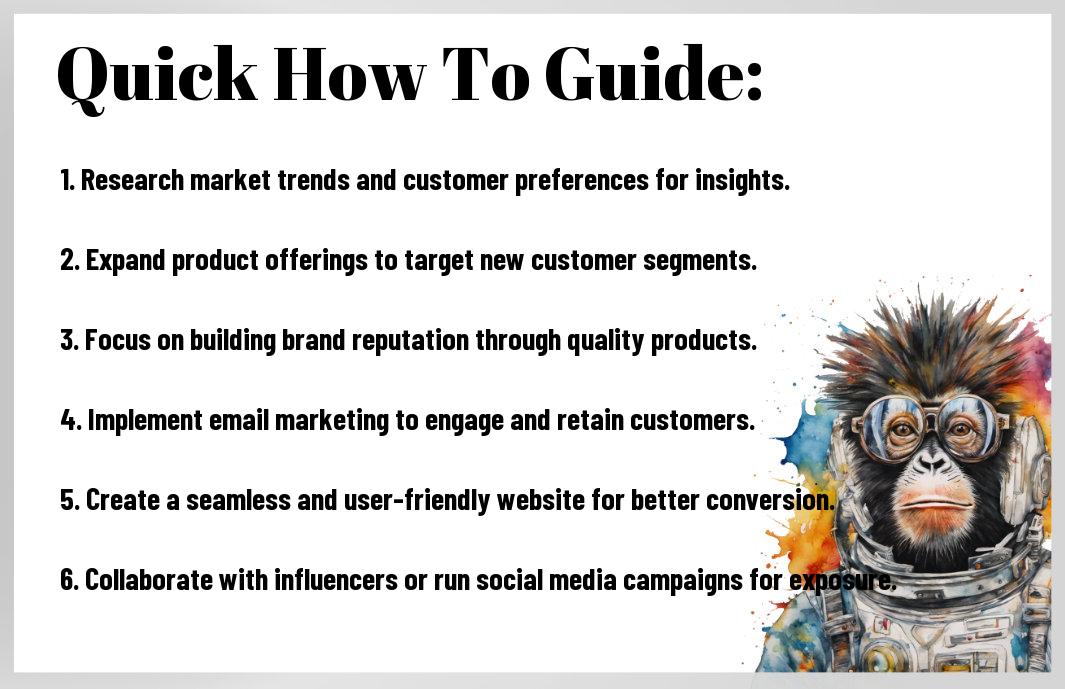How To Evolve Your Dropshipping Brand Strategy For Long-Term Success
Just starting a dropshipping business is not enough in today’s competitive market. To ensure long-term success, it is crucial to continuously evolve and adapt your brand strategy. In this guide, we will explore key steps and strategies you can implement to take your dropshipping brand to the next level and establish a strong foundation for sustainable growth.
Key Takeaways:
- Focus on building a strong brand identity: Establishing a memorable brand image can help set your dropshipping business apart from competitors and create customer loyalty.
- Offer high-quality products: Providing top-notch products can enhance your brand reputation and encourage repeat customers.
- Provide excellent customer service: Responding promptly to inquiries, addressing concerns, and offering a seamless shopping experience can help build trust with your customers.
- Invest in marketing efforts: Utilize various marketing channels such as social media, influencer partnerships, and email campaigns to reach a wider audience and drive sales.
- Consider expansion opportunities: Explore new product lines, target markets, or partnerships to continue growing your business and staying relevant in the market.
- Monitor and analyze performance: Regularly track key metrics like conversion rates, website traffic, and customer feedback to identify areas for improvement and make data-driven decisions.
- Adapt to changes in the market: Stay agile and be willing to adjust your brand strategy to meet evolving customer preferences and industry trends for long-term success.

Laying the Foundation
Understanding Your Target Market
It is crucial to understand your target market before developing your dropshipping brand strategy. Researching demographics, preferences, and buying behaviors of your potential customers will help you tailor your products and marketing efforts effectively.
How-to Identify Your Unique Selling Proposition (USP)
Some businesses struggle to stand out in a sea of competitors in the dropshipping industry. Identifying your Unique Selling Proposition (USP) is key to differentiating your brand and attracting customers. Your USP should highlight what sets your products apart and why customers should choose you over other options.
How-to Identify Your Unique Selling Proposition (USP): Your USP should be clear, specific, and compelling. It should address a specific need or desire of your target market that your competitors do not fulfill. Your USP can be based on various factors such as product quality, pricing, customer service, or unique features.

Building Your Brand Identity
Tips for Designing a Memorable Logo
Now let’s probe the importance of creating a memorable logo for your dropshipping brand. A logo is often the first thing customers see and can leave a lasting impression. Here are some key tips to keep in mind:
- Simplicity is key – a clean and simple logo is more likely to be remembered.
- Choose colors that reflect your brand’s personality and values.
- Ensure your logo is scalable for different platforms and sizes.
- Memorability is crucial – aim for a design that stands out and is easily recognizable.
Assume that your logo is the face of your brand, so make it count.
Establishing a Consistent Brand Voice and Aesthetic
Brand consistency is key to creating a strong and recognizable brand identity. Building a consistent brand voice and aesthetic helps customers easily identify and connect with your brand across all touchpoints. Consistency in messaging, tone, and visual elements helps build trust and loyalty among your target audience.
For instance, using the same tone of voice in all your marketing materials and maintaining a cohesive visual style in your website design, social media posts, and product packaging can reinforce your brand’s image and make it more memorable to consumers.
Optimizing Your Online Presence
How-to Improve Your Website for Better User Experience
Despite having great products and a solid brand message, if your website is not user-friendly, you might be losing out on potential customers. Clearly, optimizing your website for better user experience is key to keeping visitors engaged and encouraging them to make a purchase. Make sure your site is easy to navigate, loads quickly, and has clear call-to-action buttons to guide users through the buying process.
Leveraging Social Media for Brand Exposure
There’s no denying the power of social media in today’s digital landscape. This platform allows you to reach a vast audience and build relationships with your customers. This is a crucial part of your brand strategy as it helps increase brand exposure and drive traffic to your website. By engaging with your audience, sharing valuable content, and running targeted ads, you can effectively promote your dropshipping business on social media.
Strategic Growth and Expansion
Factors to Consider When Scaling Your Business
Many dropshipping businesses reach a point where they consider expanding their operations to reach a larger audience and increase profitability. However, scaling a business requires careful planning and consideration of various factors to ensure long-term success.
- Market Demand: Analyze market trends and customer demands to tailor your product offering accordingly.
- Infrastructure: Ensure your systems and processes can handle increased order volume and customer inquiries.
- Financial Stability: Assess your financial readiness to scale, considering cash flow and potential investment needs.
Knowing these factors and addressing them proactively will set a solid foundation for sustainable growth and expansion.
Tips for Diversifying Your Product Range and Suppliers
Your dropshipping business can benefit greatly from diversifying its product range and suppliers. This strategy helps reduce reliance on specific products or suppliers, mitigating risks and opening up new revenue streams.
- Research: Explore new product categories and suppliers to identify opportunities for expansion.
- Testing: Introduce new products gradually to gauge customer interest and demand before scaling up.
- Relationship Building: Cultivate relationships with multiple suppliers to ensure a reliable and diverse supply chain.
Perceiving the importance of diversification will enable your brand to adapt to market changes and stay competitive in the long run.
Expansion
Expansion is a critical phase for your dropshipping business. It holds the potential for significant growth but also comes with risks. By carefully evaluating your market demand, infrastructure, and financial stability, you can make informed decisions that will lay the groundwork for sustainable expansion. Diversifying your product range and suppliers is a strategic move that adds resilience to your business and enhances its competitiveness. By following the tips mentioned above and staying proactive in your approach, you can position your brand for long-term success in the ever-evolving dropshipping industry.
Customer Retention Strategies
How-to Create a Loyalty Program That Works
All successful dropshipping brands understand that customer retention is key to long-term success. One effective way to cultivate customer loyalty is by creating a loyalty program that incentivizes repeat purchases. To create a successful loyalty program, you need to offer rewards that are valuable to your customers, such as discounts, exclusive access to products, or personalized services. Make sure the program is easy to understand and use, and don’t forget to promote it to your existing customer base.
Providing Exceptional Customer Service for Brand Advocacy
Assuming that satisfied customers are more likely to become brand advocates, providing exceptional customer service is crucial for building a strong brand advocate base. By going above and beyond to resolve customer issues promptly and effectively, you can turn a dissatisfied customer into a loyal advocate for your brand. For instance, offering 24/7 customer support and personalized interactions can help create a positive customer service experience that leads to brand advocacy.
Analyzing and Adapting
Once again How to Market Your Dropshipping Business? (2024) is a crucial aspect of long-term success for any dropshipping brand. To stay ahead of the competition and remain relevant in the ever-evolving ecommerce landscape, analyzing your performance and adapting your strategies accordingly is key.
How-to Use Analytics to Inform Your Strategy
There’s no denying the power of data in today’s digital age. By leveraging tools like Google Analytics and social media insights, you can gain valuable insights into your audience’s behavior, preferences, and purchasing patterns. Use this information to optimize your marketing efforts, improve your product offerings, and enhance the overall customer experience.
Tips for Staying Ahead of Market Trends
If you want your dropshipping brand to thrive in the long run, you need to stay on top of the latest market trends and consumer preferences. This means regularly conducting market research, monitoring industry news, and keeping an eye on your competitors. By tracking emerging trends, seizing opportunities, and adapting your strategy accordingly, you can ensure that your brand remains relevant and competitive in today’s fast-paced ecommerce world. Knowing when to pivot and innovate can mean the difference between success and failure.
- Track emerging trends
- Seize opportunities
- Adapt your strategy accordingly
To wrap up
The evolution of your dropshipping brand strategy is vital for long-term success in the ever-changing ecommerce landscape. By implementing effective market research, building a strong brand identity, optimizing customer service, and embracing new trends and technologies, you can stay ahead of the competition and ensure the growth and sustainability of your business. Remember to continuously evaluate and adapt your strategy to meet the demands and expectations of your target audience, ultimately leading to increased sales and customer loyalty. With dedication and innovation, your dropshipping brand can thrive for years to come.
FAQ
Q: Why is evolving your dropshipping brand strategy important for long-term success?
A: Evolving your dropshipping brand strategy is important for long-term success because it allows you to adapt to market changes, stay ahead of competitors, and meet the evolving needs of your target audience.
Q: What are some key factors to consider when evolving your dropshipping brand strategy?
A: Some key factors to consider when evolving your dropshipping brand strategy include market trends, competitor analysis, customer feedback, and technological advancements.
Q: How can you use data analytics to evolve your dropshipping brand strategy?
A: Data analytics can help you track key performance indicators, understand customer behavior, and identify patterns and trends that can inform changes to your dropshipping brand strategy.
Q: What role does branding play in the evolution of a dropshipping business?
A: Branding is crucial in the evolution of a dropshipping business as it helps differentiate your brand from competitors, build trust with customers, and create a strong brand identity that resonates with your target audience.
Q: How can you leverage social media to evolve your dropshipping brand strategy?
A: You can leverage social media to evolve your dropshipping brand strategy by engaging with your audience, running targeted ads, sharing valuable content, and staying informed about social media trends.
Q: What are some common challenges in evolving a dropshipping brand strategy?
A: Some common challenges in evolving a dropshipping brand strategy include keeping up with changing market dynamics, staying innovative, managing brand consistency across channels, and maintaining customer loyalty during transitions.
Q: What are the benefits of evolving your dropshipping brand strategy for long-term success?
A: The benefits of evolving your dropshipping brand strategy for long-term success include staying relevant in a competitive market, attracting new customers, retaining existing customers, and building a resilient and adaptable brand that can withstand industry changes.







